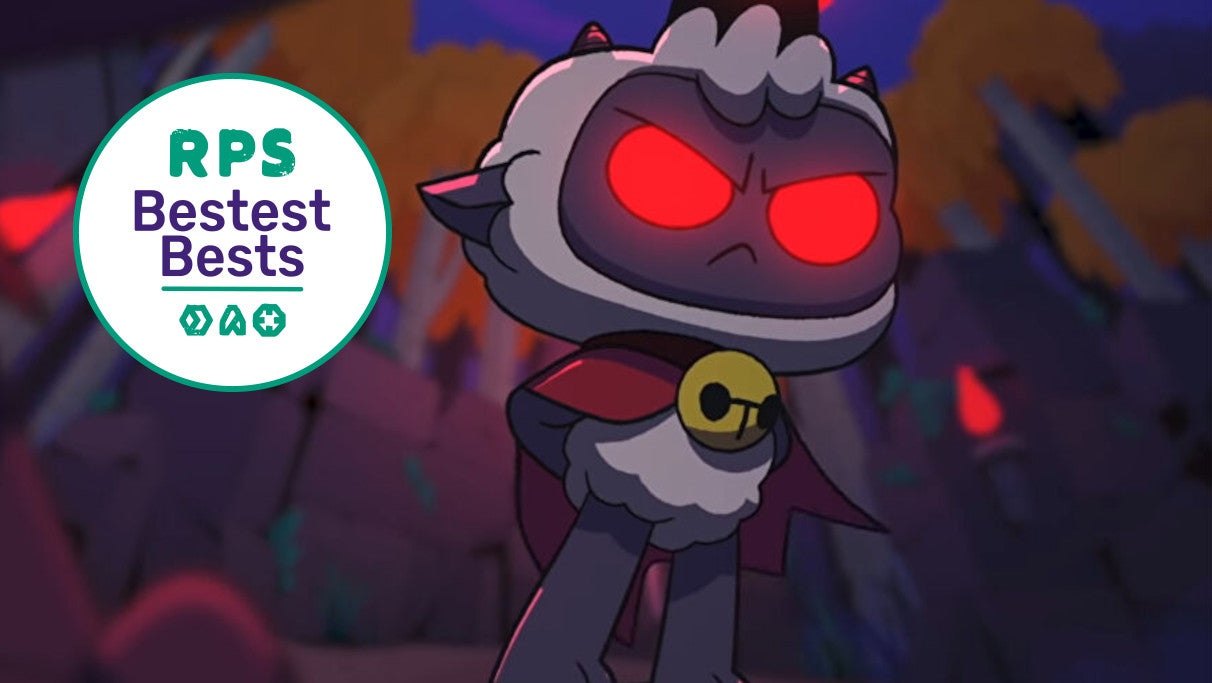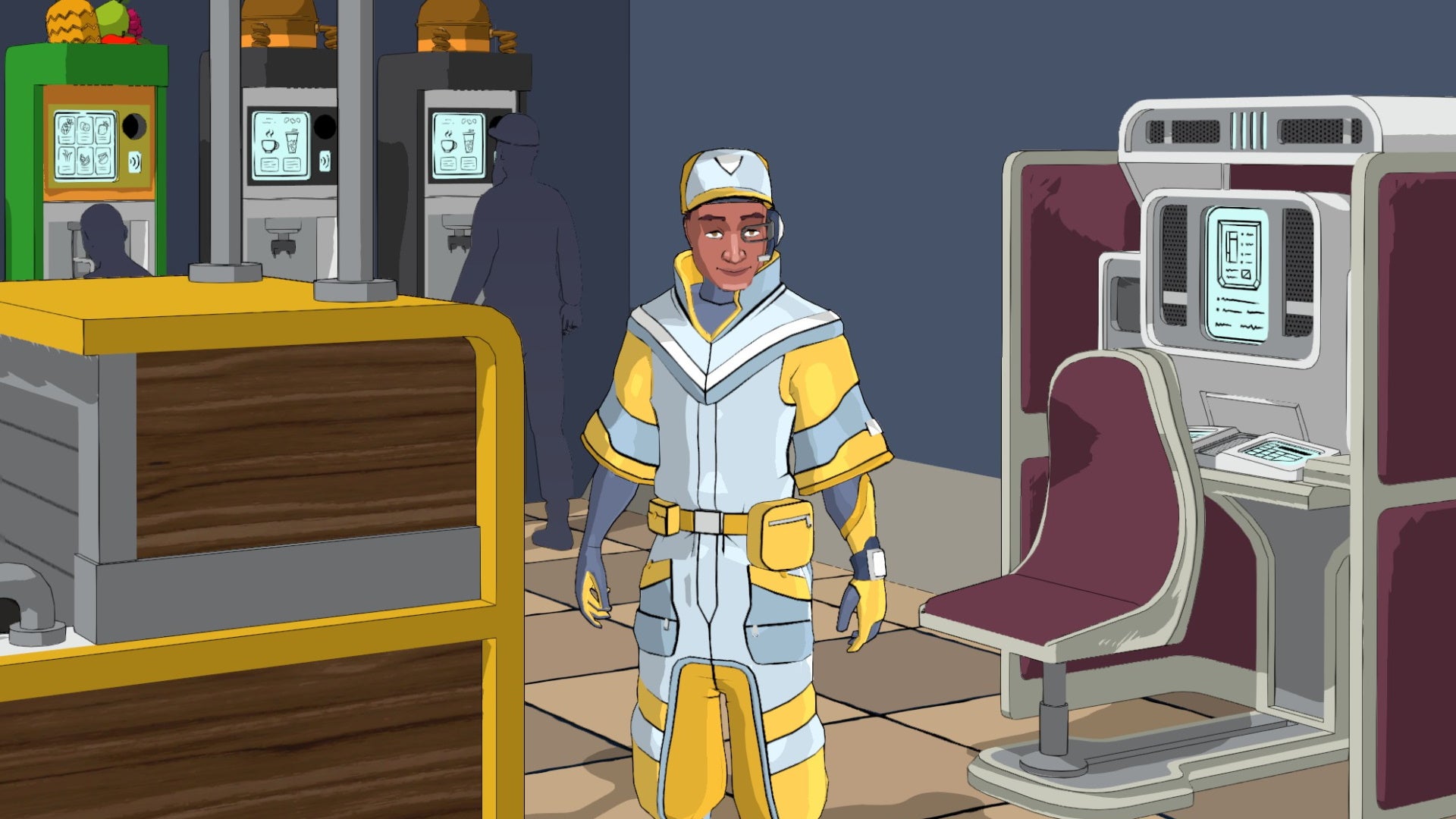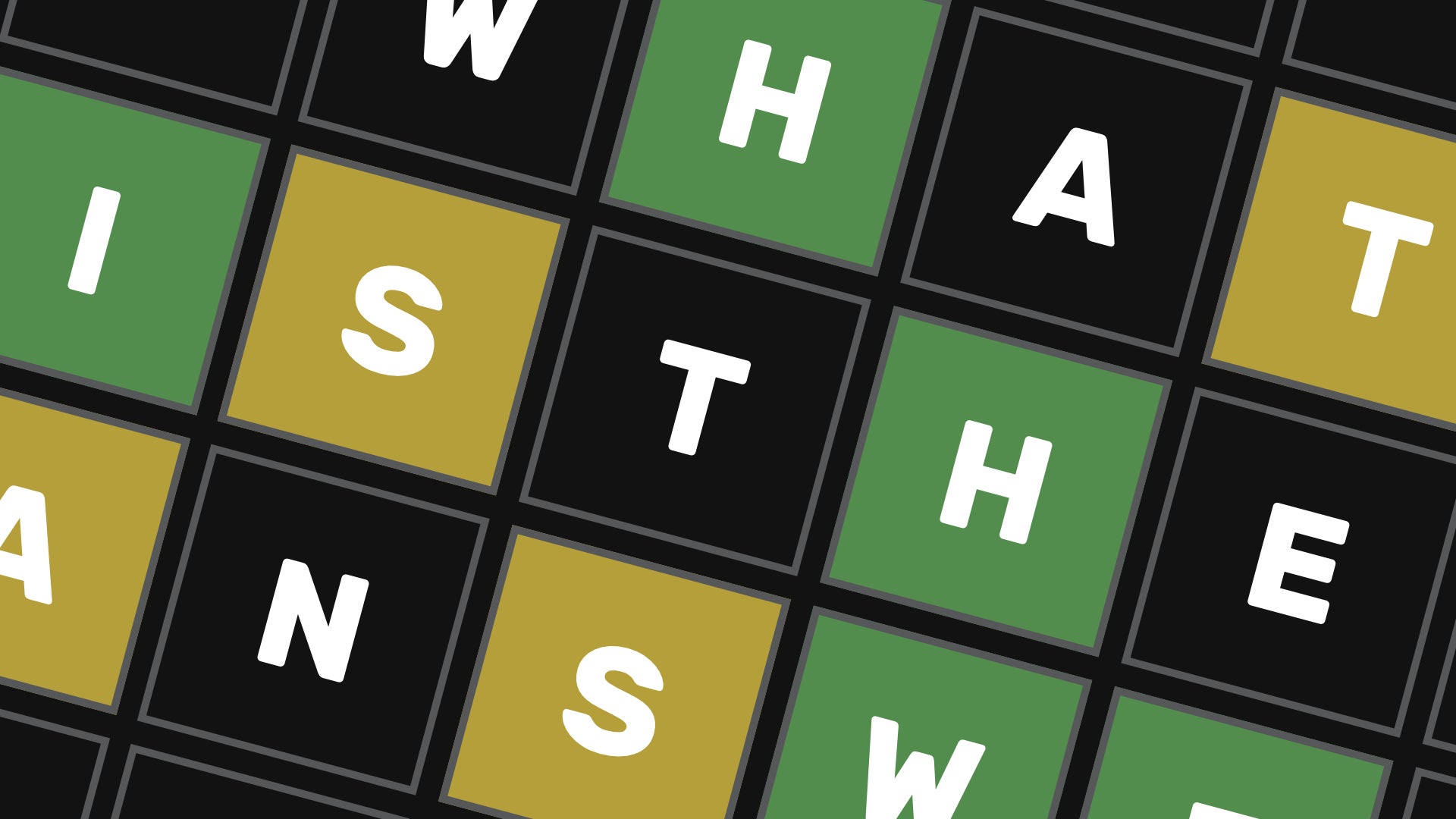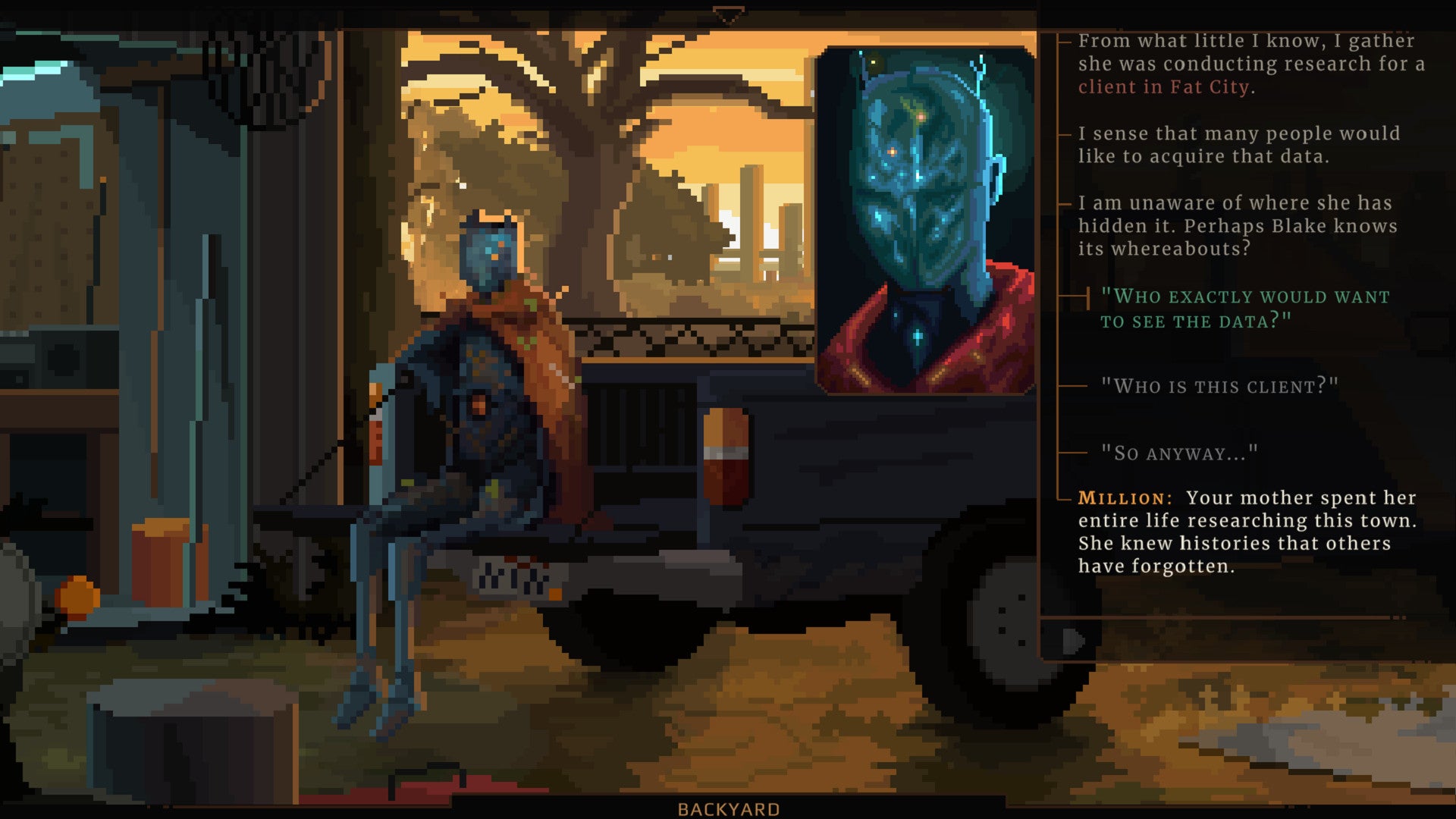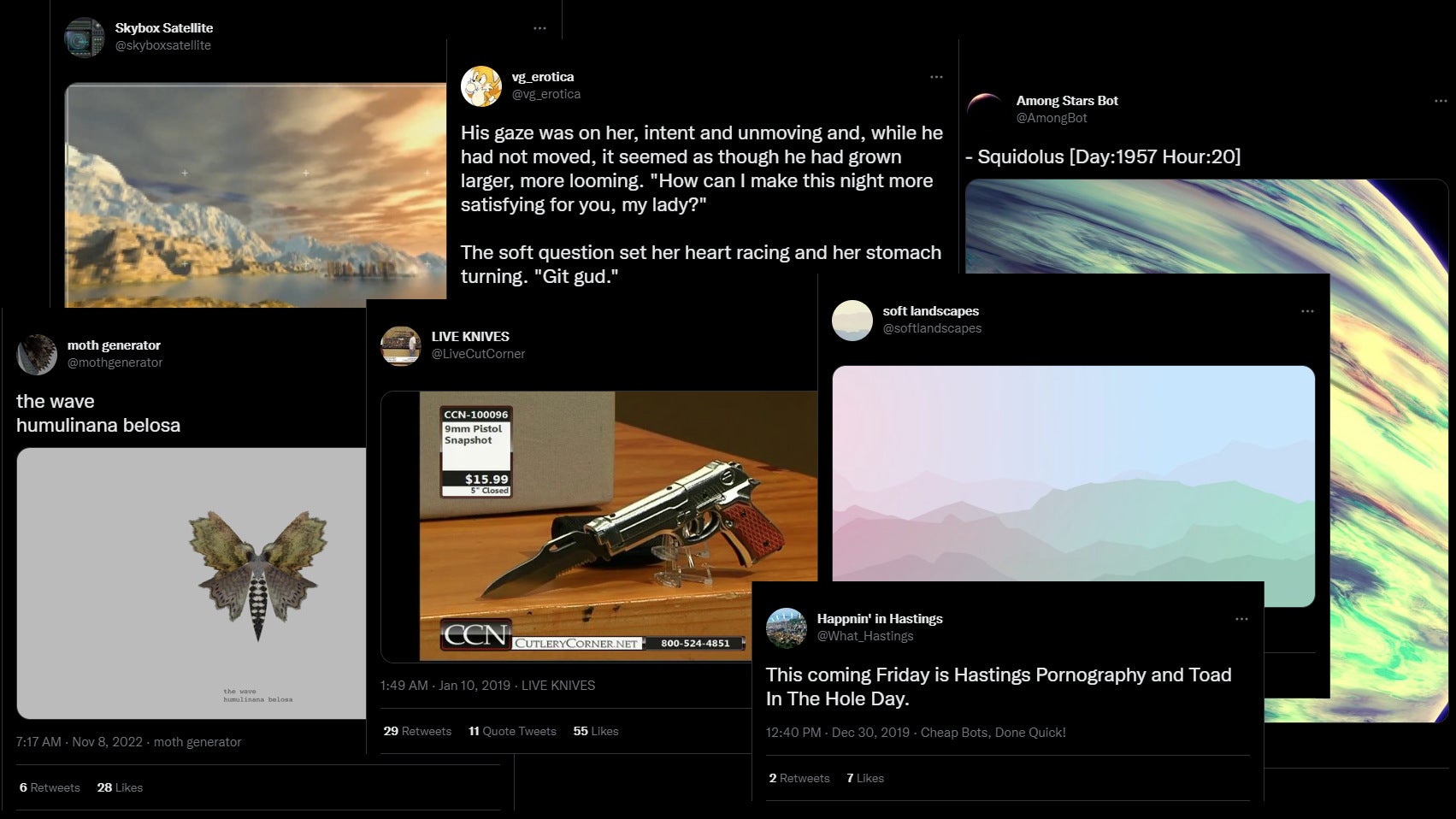Cult Of The Lamb review: an adorably twisted cult management game
Bleat-em-upA bright sun heralds the start of day 37 for CultPaperShotgun. Katharine wakes up and immediately sets to work cleaning up the mountains of poop and vomit puddles left over from the previous night's revelries. As she works, she spies her good friend Alice B harvesting cauliflowers from the cult's garden, trying to keep as far as possible away from the (now slightly rotting) corpse of Graham that lays nearby. A cluster of other followers are busy dancing around a shrine in the centre of the village, but they all stop to witness a fight between the two oldest members of the cult - Alice0 and Liam. Ritual combat of the elderly is a staple of CultPaperShotgun, and as Alice0 delivers the final blow to an ailing Liam, cries of euphoria reverberate about the camp as his spirit (and chunks of flesh) are donated to the cause.
Where am I in all this, you ask? I, the Lamb, the glorious leader of our cult, the holy vessel of Death itself, and the sworn enemy of the Bishops of the Old Faith that are destined soon to die by my blade? I'm kicking back at a nearby camp, enjoying a spot of fishing and a friendly game of Knucklebones.
This, friends, is Cult Of The Lamb. And it is excellent.
Cult Of The Lamb gets off to a roaring start. You begin life as a lowly lamb awaiting sacrifice at an altar of the Old Faith before four eldritchian Bishops - the big bosses of the game. Within seconds, you're executed. But then you're brought back from death by a chained godlike being known as The One Who Waits, who promises life and otherworldly powers in exchange for your servitude. In the span of two minutes from starting the game, you've turned from a hapless lamb into an unstoppable servant of Death itself, slashing apart Old Faith cultists like blades of fleshy grass.
With Cult Of The Lamb, developers Massive Monster have quickly cemented themselves as absolute masters of presentation and style. From the opening moments I was already marvelling at just how much panache was on display at all times. Trees and tufts of grass sway in the wind. Cultists explode delightfully into chunks of bone as my sword shwings wickedly through the air. The Lamb itself doesn't just walk forward, it charges single-mindedly towards its target with a sinister glint in its giant ovine eyes. Already, I felt like I was in good hands.
After fighting through a series of connected tutorial rooms filled with cultists and eldritch beasties, I was teleported to my new home. Here, I was introduced to the other major aspect of Cult Of The Lamb: building my own cult and managing my followers. I'd found and rescued another sacrificial animal during my escape attempt, and now they could be indoctrinated into my new cult. For the most part, followers are quite good at doing their own thing. You can give them a job to prioritise, such as gathering resources such as wood and stone, or praying at the shrine to increase your devotion and unlock new buildings. Their only real needs are food, shelter, and preferably an absence of fecal matter nearby, or else they might get sick and die.
The early days of setting up CultPaperShotgun involved helping my followers break down all the nearby rocks and trees into useable building materials, and plopping down my first few sleeping bags and farm areas. I had to do a lot of manual work to begin with, but as time went on, I started to unlock buildings that allowed me to automate certain aspects of my daily workload. And by automate, I mean get one of my lowly followers to do the work for me. So as my cult grew, I found myself with more free time to explore, talk to followers to receive small quests, and - of course - to wage war against the Bishops of the Old Faith by embarking on dungeon crawls.
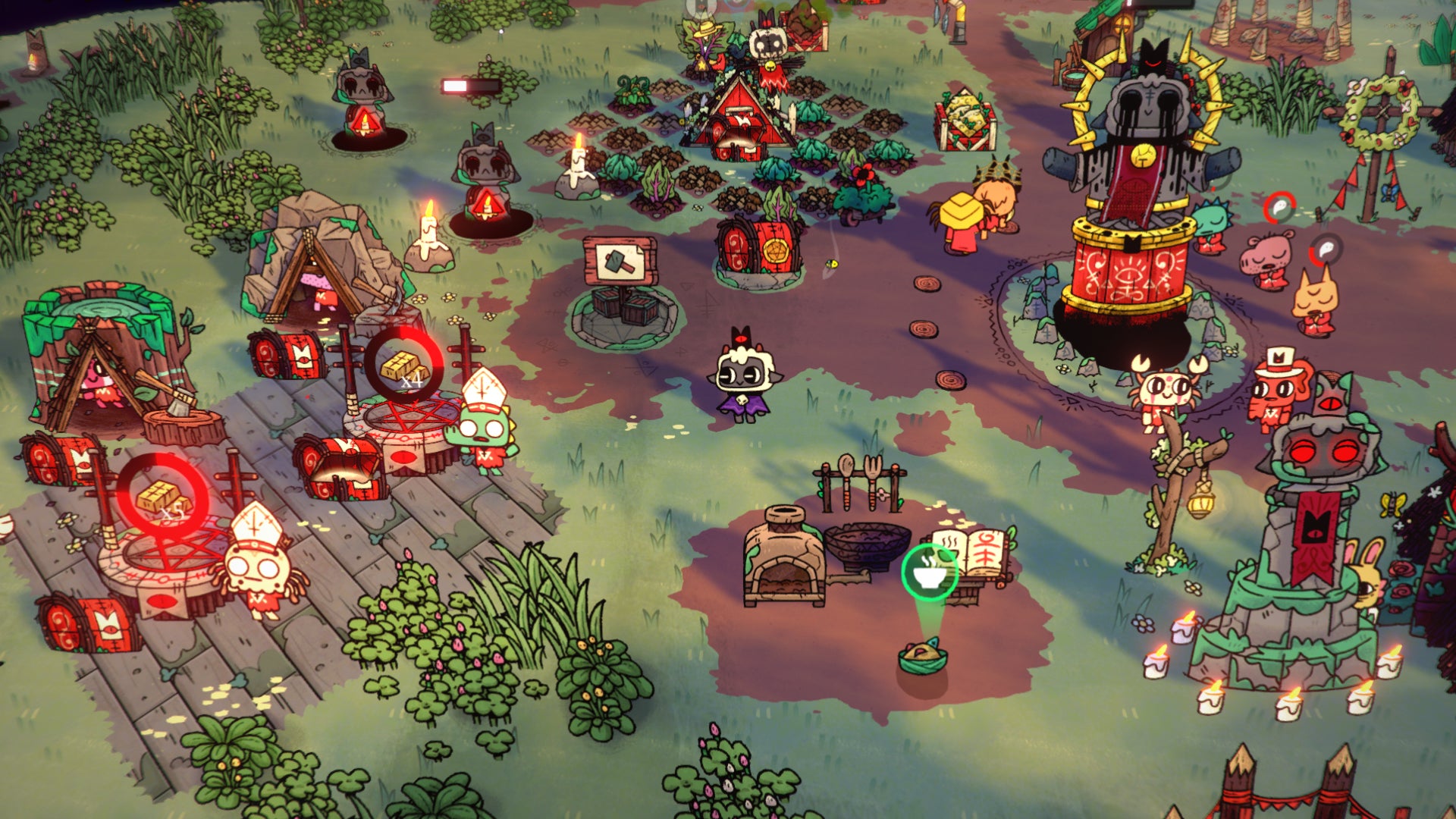
The overarching goal of Cult Of The Lamb is to free The One Who Waits from their prison. To do this, you have to track down and kill the four Bishops, each of which guards one of the chains binding the Big Ol' Patient Boi in his mystical jail. Each Bishop resides in their own domain, and you can unlock the door to each domain once you have enough followers. This means you can start working on the second domain before you've completed the first, which gives you a nice bit of freedom to mix up your runs.
Don't let the camera angle mislead you: this is less Binding Of Isaac, more Hades or Dead Cells.
The combat in Cult Of The Lamb doesn't just look great, it feels pretty good too. Don't let the camera angle mislead you: this is less Binding of Isaac, more Hades or Dead Cells. Expect lots of dodging through attacks, lots of stunlocking and backstabbing enemies. It lacks a little of the precision and polish of those two titles, but the fact that it is even comparable to two of the best combat systems in the history of roguelites is pretty good going.
You start each run with a primary weapon and a curse, which is essentially some sort of eldritch spell, like calling forth a row of damaging tentacles from the ground in front of you. The weapons aren't terribly interesting, which is a bit of a shame. As time went on I unlocked more weapon types, but they mostly boiled down to reskins of the basic four - sword, dagger, axe, and hammer - just with extra effects like poison or critical hits. The curses added some more variety though, and kept things interesting.
Over the course of a run you'll also find tarot cards, much like Binding Of Isaac, which give you bonuses like giving you extra hearts, making your dodge-roll deal damage to nearby enemies, and so on. Like the weapon choices, I did find myself a bit disappointed with the small number of tarot cards in the game (15 to begin with, and 21 more to unlock over a playthrough). The foundation of the combat is really very good, so why not make the most of it by giving players more content with which to vary their builds for each run?
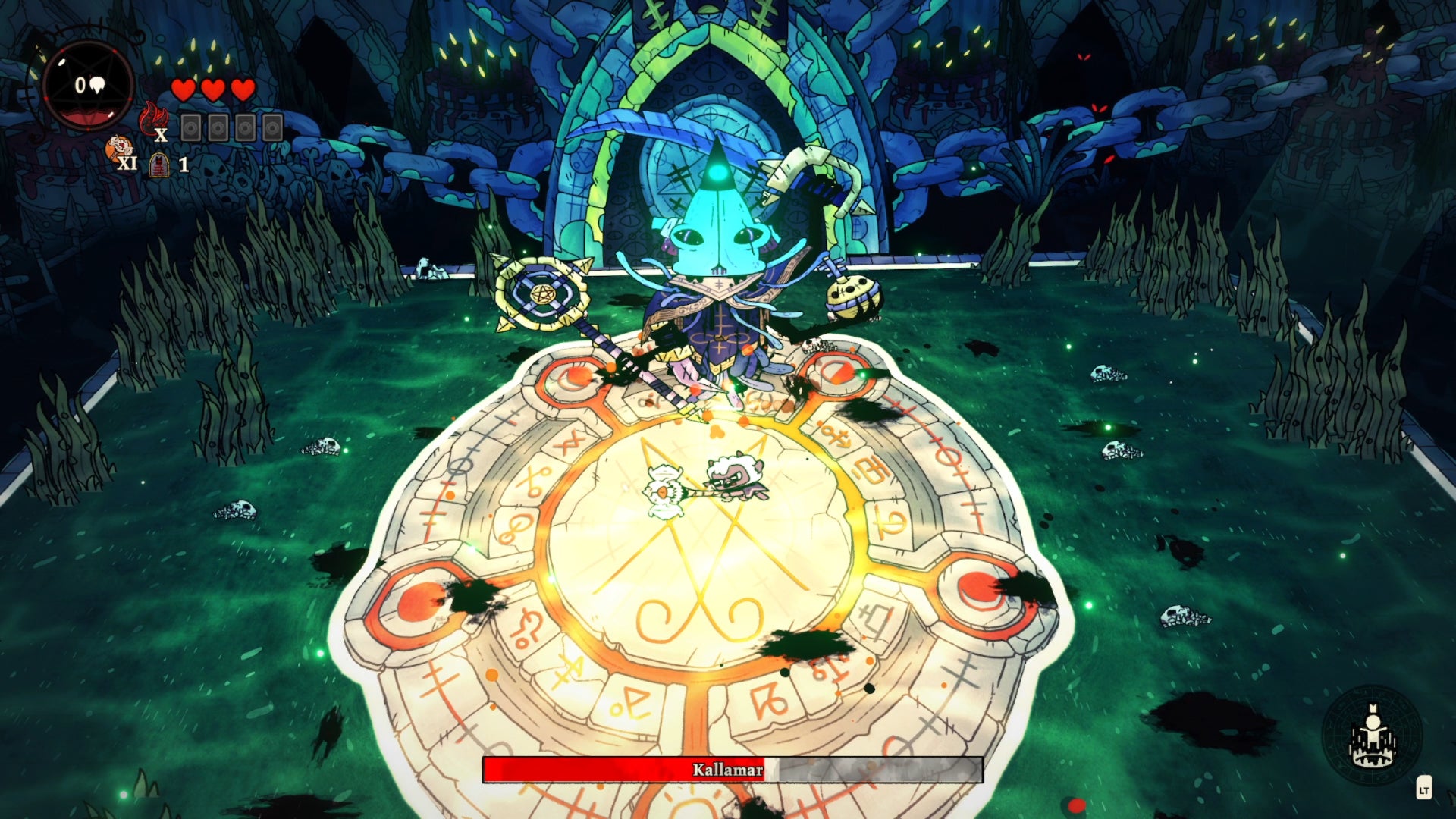
Everything else about the combat is great, though. There may have been a lack of variety in my builds, but the variety offered by the different realms and all the enemies contained within went a long way towards making up for it. Massive Monster seems to be very good at riding the line between cute and, well, monstrous. There were fuzzy horned slugs in one region, angry exploding jellyfish in another, and dive-bombing spiders in yet another. The boss design is particularly good, with the devs again clearly following in Binding Of Isaac's footsteps in creating depraved, body-horror-esque monstrosities that also manage to look strangely cute and endearing while they sludge and skitter around trying to kill you.
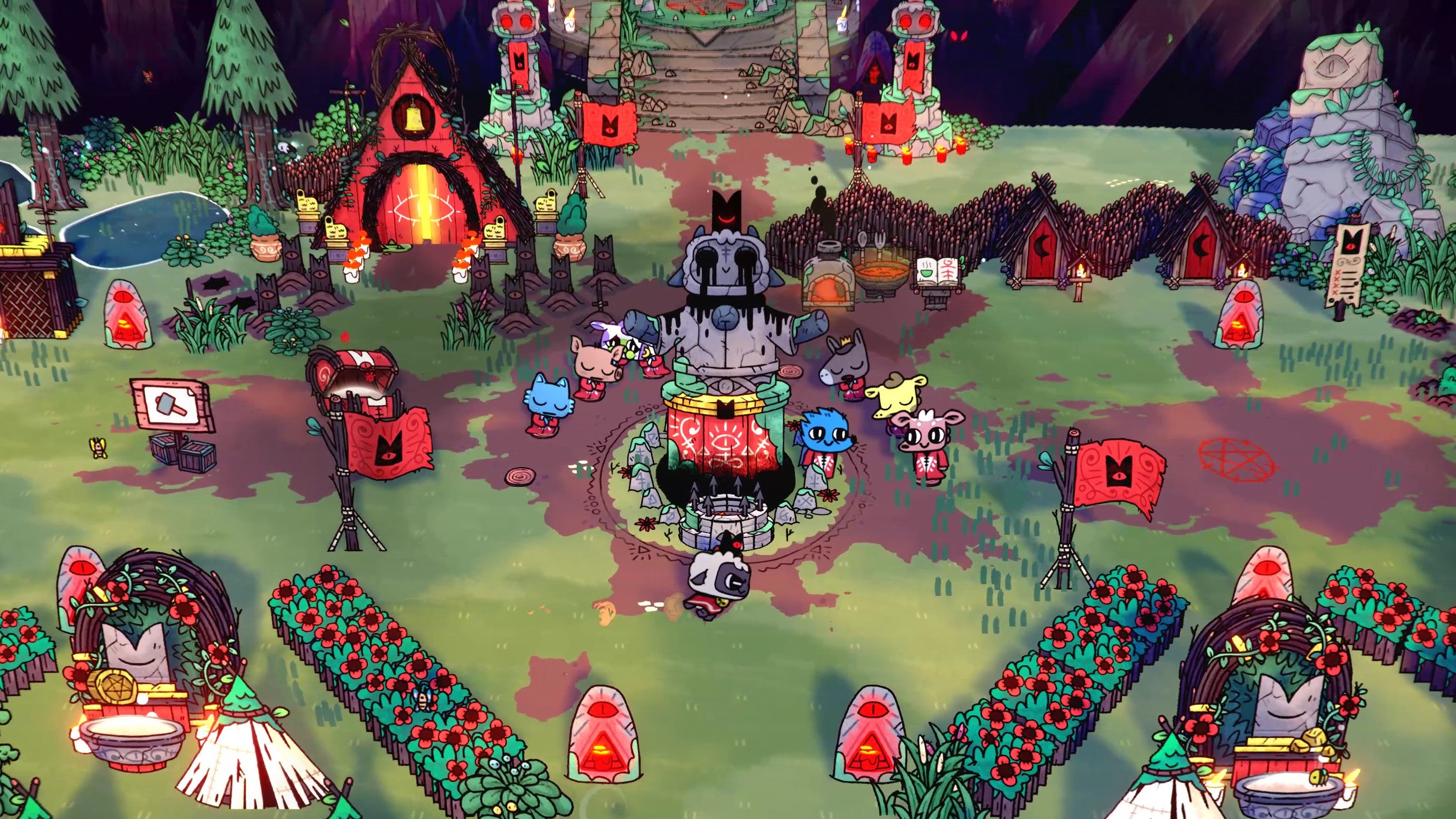
I also found the crusades to be, on the whole, too easy. I quickly set the difficulty up to Hard, and I still only fully died once. Looking back, I wish I'd set the difficulty to Very Hard from the start, and this is what I'd recommend to any player who's well-versed in the frenetic dodge-attack-dodge-attack combat loop of games like Hades.
I'm a big fan of the way the game unfolds and expands over time. Each procedurally generated dungeon is broken into different nodes and paths, a la Slay the Spire. Some nodes offer the more traditional rooms upon rooms of fighting, while others offer resources, followers to rescue, or interesting and mysterious characters to talk to and trade with. Complete the same realm's dungeon run four times, and you can challenge the Bishop in one final boss fight. Once you win, the realm then opens up further, allowing you to embark on endless dungeon runs that only stop when you die or decide to teleport home to your cult.
As time went on, the game also found ways to cleverly tie together the dungeon-crawling parts with the cult management parts. At one point I unlocked a summoning circle building which allowed me to convert one of my followers temporarily into a spiky little demon that could aid me in my next crusade. Another time, I entered one Bishop's realm, they visited me in all their ghastly towering glory and cast a famine upon my cult back home. Time doesn't stand still while I'm off adventuring; the cultists have to be able to survive in real time while I fight, or I might come home to find half my followers dead. So that was a proper "oh shit, okay" moment for me. I was on the clock. My followers were counting on me to end the run quick, or they'd starve.
At another point, a lucky shot from an Old Faith cultist managed to strike a would-be killing blow on me. But thanks to a perk I'd selected earlier in the game, I could choose to sacrifice one of my followers back home in order to come back to life. Sorry, Rachel. You died for a noble cause.

You may recall that earlier on I mentioned ritual combat of the elderly. Yep, that's a thing in my cult, and I'm quite proud of it actually. Followers age and die in Cult Of The Lamb, and that presents problems such as bodies that need burying before they rot and make everyone sick, and also the sadness of other followers lowering the amount of Faith in the cult as a whole. Faith is very important - just as important as food and health - because if your cult's Faith runs too low, your followers will start to dissent, spouting falsehoods to other followers. And then eventually they'll leave you.
There are plenty of ways to keep Faith in your cult high, such as delivering daily sermons, completing quests, embarking on successful crusades, and so on. But you can also unlock and enact rituals as long as you have the resources. Some of these resources lower faith in order to give you benefits; for instance, I can sacrifice a follower in order to become more powerful, but the other followers may frown on that. But then I passed a couple of doctrines that dovetailed perfectly with one another. The first doctrine allowed me to declare combat rituals between two followers, who would promptly fight to the death (unless I choose to let the loser live, which I never did). The second doctrine touted the glory of the afterlife, and actually gave all cultists a boost to their Faith whenever one of their members was sacrificed as part of a ritual.
I actually think I spent more time outside of dungeon crawls than inside them during my playthrough - and I'm perfectly happy with that.
Thus began the tradition where the old people in my cult would be paired off and forced to fight to the death. Not only would it mean one less body to deal with, but it actually became a source for celebration amongst the village as one of their most venerable members got to "ascend" to the afterlife. Cult Of The Lamb encourages pragmatism at every turn. It probably isn't the best fit for people who don't have an evil streak somewhere deep inside them.
Hopefully I'm getting across that those of you expecting a pure roguelite should be prepared for a surprise. I actually think I spent more time outside of dungeon crawls than inside them during my playthrough - and I'm perfectly happy with that. It turns out there's an awful lot to be getting on with besides fighting. Making sure your followers are clean and well-fed is a full-time job as it is, and besides that there are also various other areas that you can travel to and meet new characters. One area, known as Pilgrim's Passage, is home to a fisherman who also happens to be a fish themselves. You can come back to this area whenever you like to do a spot of fishing, and bring home your catches to create more pleasing meals for your followers than the usual grass soups and spider-meat stews they're used to having.

Another minigame can be played in the Lonely Shack, an area to the northwest of your cult. There you can challenge various NPC characters to a game of Knucklebones - a surprisingly engaging little dice game that favours both luck and skill. It's extremely simple, and it wouldn't keep me occupied for very long as a standalone game, but as a minigame it's actually quite layered and interesting, particularly when the opponents get cleverer over the course of your playthrough.
I also need to spend a bit of time extolling the wonderful soundtrack by Narayana Johnson, aka River Boy. It's an unlikely pairing of jovial cottagecore and otherworldly danger, and every second of it ties in flawlessly with what's happening at the time in-game. Each theme perfectly reflects the nature of the environment you're in, from the comfortable, fruity electronic backdrop of life in the cult, to the sinister and frenzied melodies that accompany the game's fighting segments in each realm. After just my first day of playing, I went to bed with the music stuck resolutely in my head.
The production quality of this game is just off the charts.
The production quality of this game is just off the charts. Even something as menial as blessing a follower or pressing a button to declare a new doctrine feels like a MOMENT thanks to all the effects and pomp and character. As you hold down the button, the screen starts to shake, a crescendo builds, and a bell tolls at the moment of completion. It might be enough to annoy some people who just want the button to be pressed and the MOMENT to be over with already, but it's done with so much style that I lapped it up. Little details like this really elevated the whole experience. It made me feel excited whenever anything happened, no matter how small. There aren't many games out there that make me look forward to delivering a sermon.
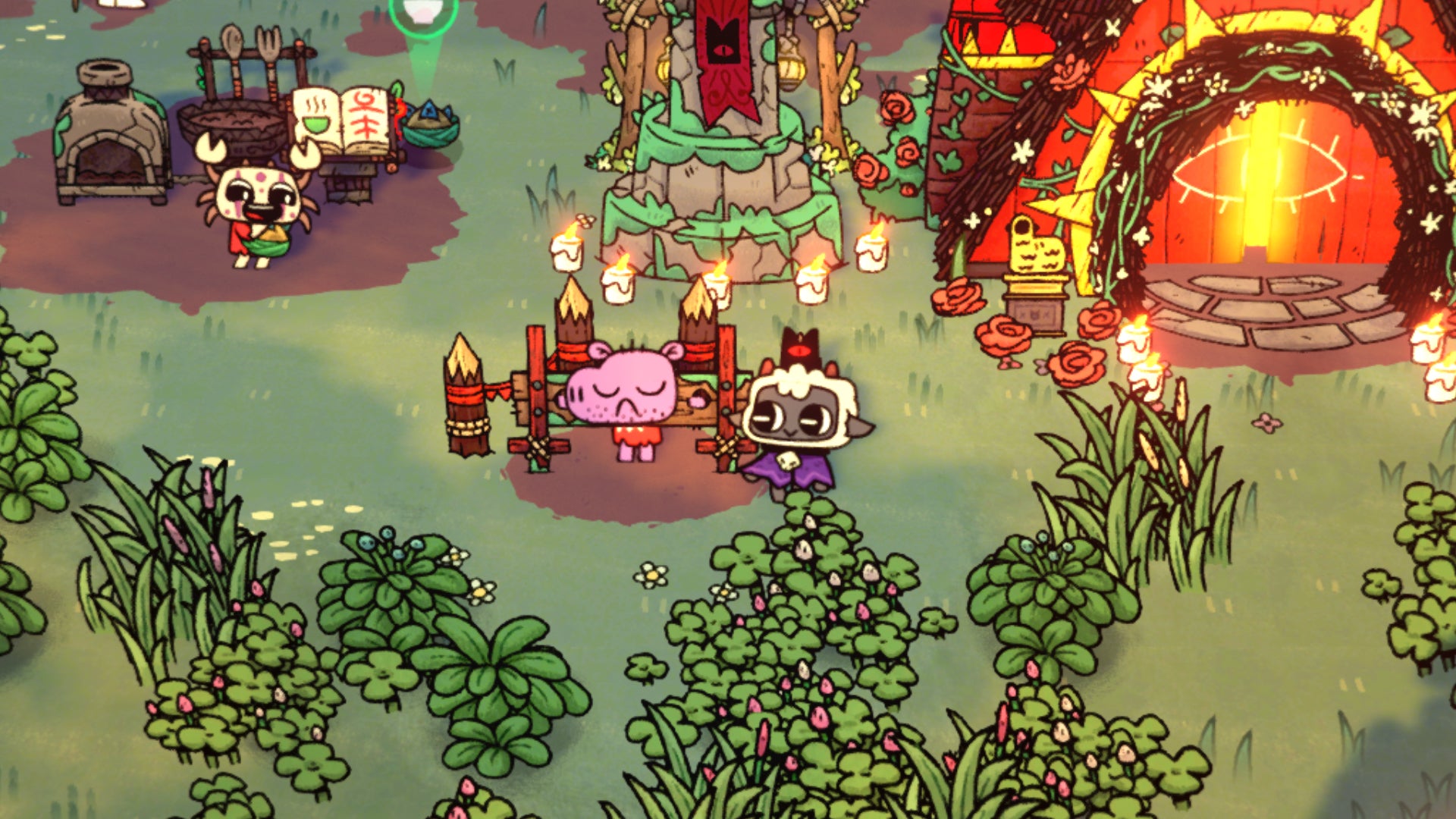
With a satisfyingly climactic ending, I finished the game after 14 hours of play, which isn't very long at all for a roguelite, nor a management game to be honest. To be fair, there was more that I could have done. I hadn't finished every character's quest, and also in my haste to sample all of the different realms and get to the final boss fight, I'd neglected the opportunity to embark on the endless dungeon runs that I unlocked after defeating each Bishop, which is where the longevity of a run is really meant to kick in. It's just marred somewhat by a lack of content in some areas. It might not be fair to compare Cult Of The Lamb to a game like Binding Of Isaac with its hundreds upon hundreds of items and powerups - particularly when the roguelite aspect is just one aspect of the game. But with a foundation as good as this, it feels like a shame that after a few hours of play, it'll be quite rare for a run to surprise you with a unique series of weapons and ability powerups. A game this good deserves a lot more content than it currently has and hopefully future updates will deliver this.
Nevertheless, I thoroughly enjoyed my time with it, and I definitely won't be alone in that. Cult Of The Lamb absolutely oozes charisma and excitement at the tiniest opportunity, and it's hard not to be taken in by the loving attention to detail on display while you're playing. The combat aspect may be a little lacking in content, but it's good enough to hold its own and keep me entertained between periods spent carefully taking care of my growing legion of adoring followers. And sacrificing them for my amusement, of course. That bit's important too.

